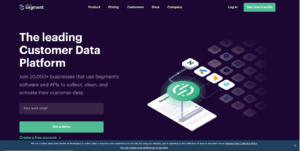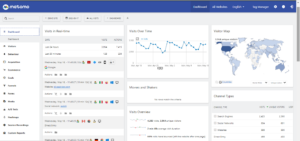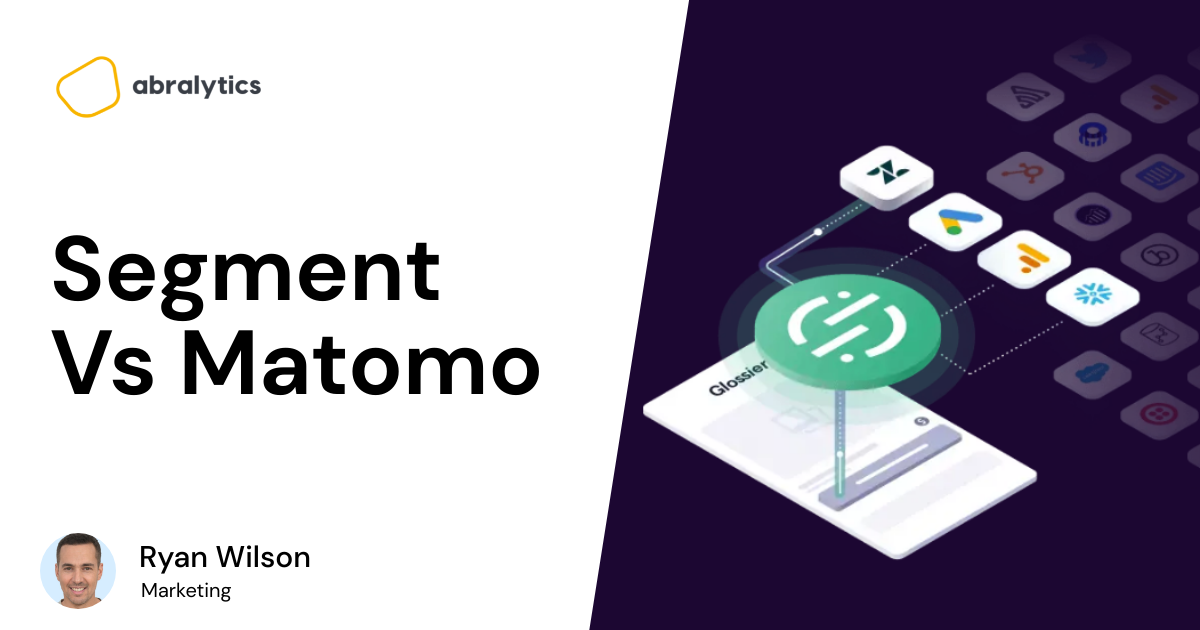In today’s digital world, there are many options for an analytics solution that can help you track, report, and store your website’s analytics data. So, it’s crucial to compare what each has to offer.
Before choosing a web analytics tool for your business, here are some core considerations:
- your organizational goals
- cost relative to your business size
- user-friendliness of the tool
- advanced features
- data privacy
- loading speed
Read on if you are looking for good analytics tools and want an in-depth Segment vs. Matomo comparison before making up your mind.
This article covers the key differences between these analytics tools – their main advantages, pros and cons and the best tool for different audience types.
What Is Segment?

Source: Segment Home Page
Segment is an analytics tool that collects, processes, stores, and reports data based on users’ activities on your digital properties like websites, apps, social media, etc.
It is a Customer Data Platform that makes collecting and using visitors’ data from digital properties easy.
You can also integrate data from other analytics tools with Segment to better understand how users interact with your website. This allows you to make better data-driven decisions, track your website’s performance and improve your customer’s experience.
Some of the tools you can integrate with Segment include:
- Customer Relations Management (HubSpot, Dynamics, etc.)
- Email Marketing tools (Sender, MailChimp, etc.)
- Analytics tools (Abralytics, Google Analytics, Matomo, etc.)
- Marketing Automation tools (Eloqua, Marketo, etc.)
- Visualization tools (Google Charts, FusionCharts, etc.)
- Messaging platforms (Signal, Customer.io, etc.)
Segment provides services for a wide range of professionals such as digital marketers, product managers, website owners, data analysts, data engineers, etc.
What Is Matomo Analytics?

Source: Matomo Home Page
Matomo Analytics (formerly Piwik Analytics) is an open-source analytics solution built with PHP MySQL software for tracking and reporting website traffic and how users interact with the site.
Matomo’s data reports inform you about your users, their activities on your site, what marketing channel they came from, and how they convert…or bounce off your website.
So you can see what works and what doesn’t on your marketing funnel to improve conversion.
Also, Matomo gives you complete control over the data on your website. No one else can access your website data without your permission.
The Core Similarities Between Segment And Matomo
They both:
- perform advanced marketing functions such as conversion tracking and data piping without the need to visit a developer – thereby saving time and stress
- offer an Application Programming Interface (API) to make communication with developers easier
- are open-source tools – you can view and inspect their analytics tracker code on GitHub
- create and use tracking and analytics events like real-time users, user locations, devices, operating systems, etc.
- feature tags for sending data to a third-party or embedding data from a third party to a website
- give you 100% data ownership of your analytics data
- use first-party cookies to identify new users
- have free and paid versions.
The Core Differences Between Segment And Matomo
Segment and Matomo serve unique purposes. Here is a breakdown of the core differences between them:
- Primary Function
Segment is a Customer Data Platform and Matomo is a web analytics platform.
Segment converts data into a general group to aid marketing tool integration. Segment’s primary focus as a CDP is allowing various tools to synergize.
On the other hand, Matomo provides detailed reports on your website, its user, and their relationship. As a web analytics platform, the focus is to track, analyze, and report your analytics data. So, you can gain insight into what to change in your marketing funnel for the best conversion.
- Pricing Plans
Segment has three versions – Free, Team and Business.

Source: Segment Pricing Chart
- Free:
The Free version of Segment costs $0/month and can track up to 1000 visitors per month, 2 sources, and 300+ integrations.
It is ideal for startups and other small businesses. Some businesses using this plan are CodeMakers, Silverbean, etc.
- Team:
The Team version of Segments starts from $120/month. It can track up to 10 000 visitors per month, unlimited sources, 1 data warehouse destination, plus the features of the Free version.
It is suitable for small and mid-sized enterprises. Examples of companies using this plan are Logg, AutoPilot, Fast Company, etc.
- Business:
The Business version of Segments has custom pricing. So, you pay based on your use. In addition to the features of the Team version, it offers services like Custom Volume, Historical Replay, Single View of Customer, Data Governance, Advanced Roles, and Permissions.
It suits big businesses, large firms, and corporations. Some examples of these companies include IBM, Fox, ClearScore, etc.
Matomo, on the other hand, has two models – Cloud and On-Premise.
- Matomo On-Premise:
This Matomo version is free. To begin, you will need to host it on your server. However, you can buy specific bundles to improve your analytics.
Some examples of these bundles are SEO web vitals (starting at $86.67/year), multi-channel conversion attribution (starting at $86.67/year), and Roll-Up reporting (starting at $218.33/year).
- Matomo Cloud:
Matomo Cloud is hosted on Matomo’s server, and the price depends on the traffic and usage of your website. The cost ranges from $0 (21-day free trial) to $15,250 yearly.
- Hosting:
Both tools can be hosted in two ways.
For Segment, the two options are cloud mode and device mode.
- Cloud mode:
The Cloud mode is hosted on Segment’s server. In this mode, the sources send data directly to the Segment servers, translating it for each downstream destination before passing it on.
Translation gives a small page size, method count, and a faster load time.
- Device Mode:
In this mode, you add a piece of code on your website or mobile app that allows Segment to use the data collected on the device to make direct calls to the destination tool’s API without first sending it to the Segment servers. However, the data is asynchronously received by Segment’s server.
For Matomo, you can choose between Cloud Hosting and Hosting On-premise.
- Cloud Hosting:
Cloud hosting entails that you host the analytics tool on Matomo’s server. If you want to set up Matomo like Google Analytics, this is the option for you. Matomo is responsible for the maintenance and updates.
- Hosting on-premise:
Hosting On-Premise entails that you host Matomo on your server. So you have the option to tailor your experience to what you need by buying individual features or bundles. However, it requires coding expertise to set it up.
- Script Size:

Source: Pexels
The script size of an analytics tool affects your site’s loading speed. Here is how Segment vs. Matomo compares.
Because of its features and as a hub for analytics tools, Segment’s analytics.js has a large codebase.
So, Segment’s analytics.js adds about 48.2KB to each of your website’s pages.
Matomo, too, has a large codebase because of its heavy infrastructure.
Hence, matomo.js adds 22.8KB to each page of your website.
Comparatively, Segment has a larger script size than Matamo. As a result, Segment makes your website slower than Matomo.
- Trackable Metrics
Basic tracking features in both analytics tools track similar metrics such as real-time users, user locations, device and operating system, etc.
If you opt for Segment, you can track from 1000 to an unlimited number of visitors (based on your plan). Also, you can add 300+ integrations, an unlimited number of users, sources, custom dimensions, and segments.
With the basic Matomo Cloud, you can only add 30 users and track 150 goals, 100 segments, 30 websites, and custom dimensions.
Because Segment is a Customer Data Platform, you can track more metrics on the tool than on Matomo.
Meanwhile, Matomo offers both server log analytics and intranet analytics.
From the intranet analytics, you can see the unique website visitor data of people in your intranet network at a glance.
Who Can Use Segment?
Segment is a good fit if your company has a website and mobile apps (iOS, Android, and OTT), and you want to send the same data to Google Analytics, Google Ads, Salesforce, a data warehouse, or any other analytics tool.
Also, if you want a central hub for your Martech stack (the set of tools that marketing professionals use to manage, measure and improve their marketing efforts), Segment is the go-to tool. The goal is to share the same code base across all destinations. So, Segment gathers hits from your single code base and routes them to your other analytics and marketing tools.
Who Can Use Matomo?
Matomo is an open-source analytics tool that offers diverse business intelligence solutions and puts you in charge. So, if you want an analytics solution that offers 100% data ownership, Matomo is an excellent option for your business.
Again, if you want no-data-limits analytics, then Matomo is a good fit for your business. This means that Matomo reports all your website data with no filters!
Pros & Cons of Segement & Matomo
Here are some of the core benefits of Segment over other CSP tools and their drawbacks.
Pros Of Segment
- Single Code Base
Segment is a single code base system. This system ensures that data is consistent across all databases. Segment collects and processes hits before forwarding them to your destinations. Streamlined data is a big plus to any business.
- 300+ Integrations
Segment is a CSP platform that offers more than 300 integrations. It covers most of the other big-name analytics tools. So, you can test new tools with minimal commitment or get started quickly with your integrations.
- Quality Assurance
Segment offers built-in quality assurance. It includes many features to help ensure that your data analysis is done correctly.
For example, you can use Segment’s Protocols to create mappings and ensure that your events fire with the correct properties. This feature is critical for data integrity, particularly in large organizations.
Cons Of Segment
- Less Flexibility
Unlike Google Tag Manager, the interface does not allow you to simply add tags or create events. So, you will have to rely on your developers whenever you want to add a new event or variable.
- Cost
Although Segment offers a free version, it can only cater to 1000 visitors monthly. That is relatively small for many companies. Meanwhile, the paid plans, Team ($120/monthly) and Business (customizable pricing) are a bit too pricey for small businesses.
Matomo: Pros & Cons

Source: Matomo Dashboard
Here are some of the core advantages of Matomo over other analytics tools and their drawbacks.
Pros Of Matomo
- Dual Hosting Options
Matomo offers two options – Cloud and on Premise. You can host Matomo on your server and track data within your MySQL database. Otherwise, you can host Matomo on the company’s cloud.
- Heat & Scroll Map Tools
Matomo features a heat map tool that shows how your website’s visitors navigate it. In addition, Matomo uses the Scroll Map tool to visualize how far down your web pages your visitors are scrolling.
- Form Analytics
Your form analytics are set automatically with the Matomo analytics tool.
The overview report shows your form metric, such as how long it takes people to fill out your form, how many people fill out your forms, etc.
Cons Of Matomo
- Complex Analytics
Matomo is a complex analytics tool because of its infrastructure. If you are new to analytics, it is not one of the best options.
However, you can opt for Abralytics, a simple analytics solution that can cater to users with any level of technical skills.
- Large Script Size
Matomo has a similar infrastructure to Google Analytics. So, it is built with heavy Javascript code. For context, Matomo’s script is 22.8 KB. That’s how much weight it adds to your website’s pages!
Consequently, it slows down your website.
Final Verdict

Source: Pexels
In summary, it is crucial to state that Segment and Matomo are two unique tools that serve different purposes. For context, both tools complement each other to improve your Martech stack.
We have discussed both tools extensively in this article, including their similarities, differences, use cases, pros, and cons.
So, if you want a central hub for your analytics data that integrates other analytics tools, you should opt for Segment.
Meanwhile, Matomo is an open-source analytics solution that gives you complete control over your website data.
However, Abralytics is the ideal Google Analytics alternative because it is simple, jargon-free, and simple to use for anyone.
If you found this article helpful, check out similar articles on Abralytics.
Other related articles




